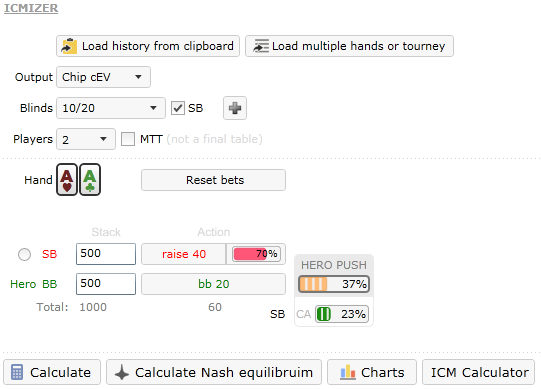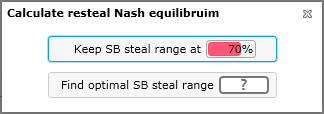Find optimal plays in SB vs BB steal spots
ICMIZER Nash calculator now supports resteal spots for SB vs. BB situations. The scenario is very common: you are BB, and SB makes a raise. Now you think that you have a rough idea about his/her raising range, however you may not guess your optimal resteal range for this spot, given that he/she can also vary his/her calling range versus your push.
Before you could use Charts to visually find optimal resteal range, but now default Calculate Nash equilibrium button does it all for you automatically.
Opponent can minraise, or make a different sized raise. In different cases our poker calculator will find different ranges. The bigger the raise, the more interesting it becomes for BB to push and take down dead money, when SB folds.

Our poker calculator offers two types of analysis of this spot:
- Keep SB range as user has entered it, and find optimal BB push range, and SB call range of that push
- Do not fix SB range, and find “optimal” SB raising range too

More details about Nash equilibrium calculation modes
Calculating Nash equilibrium for current SB steal range
In this mode you assign SB a steal range, and ask ICMIZER to calculate Nash equilibrium resteal pushing range for BB, and SB call range versus that resteal range. As usual SB call range will be a part of his/her steal range. He/she cannot call with hands, which he/she didn’t raise with.
This mode will be preferred by players. It is very practical, and you can play around with raise range. You can assign a polarized range for SB raise, and find optimal BB response. Or if you have specific opponent you could assign him a wider or narrower range depending on your observations, and calculate opponent specific Nash shoving range.
If you are SB, you can figure out how BB can optimally respond to your raise. And of-course you can find out which part of range to call with, should BB push optimally against your range.
Note that it’s crazy to expect anyone to be exactly on Nash range, so this should be used as guidance, not a hard rule ranges. You get optimal ranges, and then play around with them, applying your game understanding during process. This will make results much more helpful.
Nash equilibrium for resteal with optimal SB raise range search
This mode will provide you with more theoretical results than previous. ICMIZER will solve a certain sub game of poker, where SB can only raise or fold given amount and BB can only push or fold in response to his/her raise.
It will choose SB steal range, which will grant highest EV in this game, compared to other options. Note that for larger stacks in heads up optimal SB steal range in this game is always 100%. This is result of strict rules of the game, which blocks both players from other options (like call for BB player).
It will be most useful for shorter stack SB play analysis and probably useful for SB vs. BB play in non-heads up phases of poker tournament.
Nash equilibrium calculation limitations
Often you will calculate Nash equilibrium, and then hit calculate button. Actual BB range will be different than Nash equilibrium range. Usually it will be slightly different, but in extreme cases it can notably jump too.
You will usually experience this in non heads up spots. In MTT or SNGs ICM can seriously pressure players, making a scenario where BB pushes and SB call really disastrous for BB player. However ICM also forces SB to play accurately versus BB in same spot, so he/she cannot call him very wide often, after he/she performs a resteal.
As a result of this ICM pressure slight changes in SB call range may cause big changes in BB shoving range, especially if SB raising range isn’t very wide. In this case even a single basic hand like ATo present in SB call range may mean that BB has to tighten up his/her shove range by several percentages. If however SB doesn’t call with that hand BB can suddenly shove much wider.
So there is no stable equilibrium to be found in this spot, if we consider hand ranges to either contain or miss a certain basic hand.
So as usual ICMIZER will find an approximate Nash equilibrium solution. And exact or pure Nash equilibrium usually doesn’t exist. Results will contain a certain compromise to stay useful. Keep this in mind if you experience this sudden jump of BB shove range.
Miscellaneous information
You can calculate resteal Nash equilibrium for HU SNG spots, and also for usual STT or MTT or SNGMTT tournaments. However it has to be unopen before SB, and he/she should be open raising.
Of-course this update is mostly targeting HUSNG players, but poker players who play other disciplines will also find some uses for it.
I hope you will enjoy this new feature. As usual, comments and questions are very welcome.